The ASUS RT-BE58 Go, first announced at CES 2025 and available in early November 2025, among other things, makes Wi-Fi 7 accessible even when you’re out and about.
As an upgrade to the RT-AX57 Go, the new travel router comes with a familiar feature set as standard ASUS routers—you will not need to learn any new tricks to make it work. From the design and specs, it’s clearly the rival to the TP-Link TL-WR3602BE, and on this front, it offers more features, including being mesh-ready via the popular AiMesh feature. Also noteworthy is that, unlike TP-Link, ASUS is not a brand facing the uncertainty of a potential US government ban.
Here’s the bottom line: If you’re looking for a well-performing, feature-rich little dual-band Wi-Fi 7 router that can do more than many standard routers, the ASUS RT-BE58 Go is a safe buy, totally worth its suggested $159.99 retail cost—its street price will vary. Get one today!
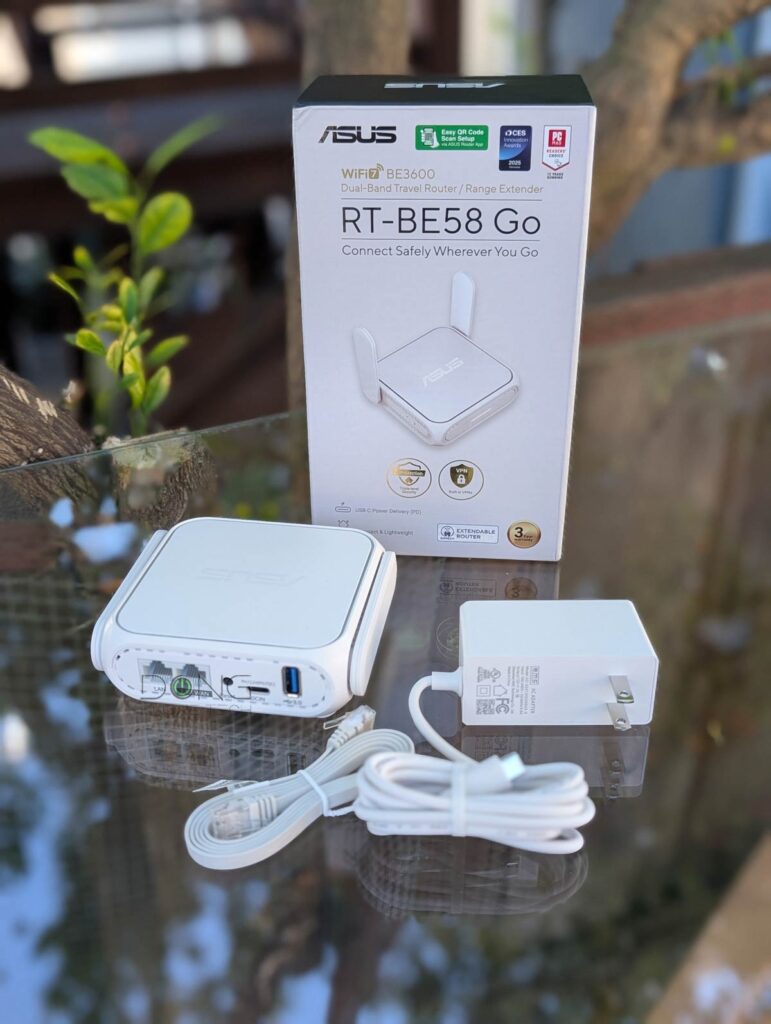
ASUS RT-BE58 Go: The Wi-Fi 7, Gig+ version of the RT-AX57 Go
Out of the box, the RT-BE58 Go looks totally different from its older cousin, the squarish RT-AX57 Go. Compared to the previous model, the new travel router now has a smaller design and two external antennas.
Still, it’s a much more powerful router thanks to the 2.5Gbps Multi-Gig WAN port (plus a Gigabit LAN port), the support for dual-band BE3600 Wi-Fi 7. Come to think about it, the RT-BE58 Go would be exactly the same as the ZenWiFi BD4 if its LAN port were also a 2.5Gbps port.
And these specs mean the new ASUS router is practically identical to its presumed competitor, the TP-Link TL-WR3602BE, which was also recently available. The table below compares the two with the RT-AX57 Go as a reference.


Hardware specifications: ASUS RT-BE58 Go vs. RT-AX57 Go vs. TP-Link TL-WR3602BE
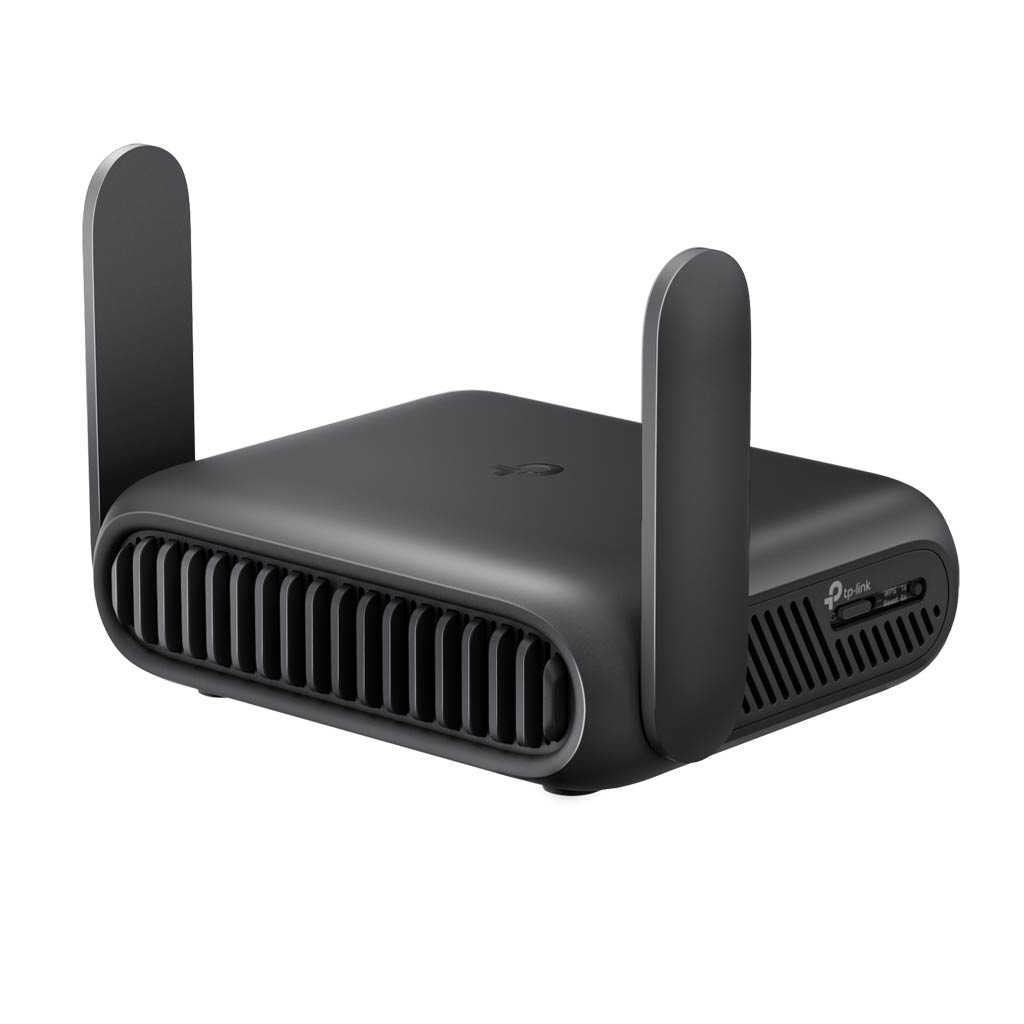 |  |  | |
|---|---|---|---|
| Full Name | TP-Link TL-WR3602BE BE3600 Wi-Fi 7 Travel Router | ASUS RT-BE58 Go BE3600 Dual-band Wi-Fi 7 Travel Router | ASUS RT-AX57 Go AX3000 Dual-band Wi-Fi 6 Travel Router |
| Model | TL-WR3602BE | RT-BE58 Go | RT-AX57 Go |
| Dimensions | 104 × 90 × 28 mm | 98mm x 94mm x 31mm | 120 x 120x 21.5 mm |
| Weight | 170 g | 232g | 200 g |
| Processing Power | undiscolosed | Quad-core 2.0GHz, 256MB Flash, 1GB RAM | Dual-core 1.3GHz SoC, 256 MB Flash, 512 MB RAM |
| Wi-Fi Technology | Dual-band BE3600 | Dual-band AX3000 | |
| 1st Band (2.4GHz) | 2×2 BE: Up to 688Mbps (20/40MHz) | 2×2 AX: Up to 600Mbps (20/40 MHz) | |
| 2nd Band (5GHz) | 2×2 BE: Up to 2882Mbps (20/40/80/160MHz) | 2×2 Wi-Fi 6: Up to 2.4 Gbps (20/40/80/160MHz) | |
| Wireless Security | WPA, WPA2, WPA3 | ||
| Built-in Cellular Modem | None | ||
| Mobile App | TP-Link Tether | Asus Router | |
| Web User Interface | Yes | Yes (open-source AsusWRT) | |
| Networking Features | VPN (Server and Client) Device-based QoS, Dynamic DNS | All ASUS Routers’ Core Features, for example: Advanced VPN (Server or client with InstantGuard) AiProtection Parental Control QoS AiMesh | |
| Operating Roles | Router Mode, USB Tethering Mode, 3G/4G/5G USB Modem Mode, Hotspot Mode (WISP Mode), Access Point Mode, Range Extender Mode, Client Mode | Router Mode, USB Tethering Mode, 3G/4G/5G USB Modem Mode, Hotspot Mode (WISP Mode), AiMesh mode (router or satellite), Access Point Mode, Range Extender Mode, Client Mode | |
| Firmware Version (at review) | not yet tested | 3.0.0.6.102_38978 | 3.0.0.6.102_22188 |
| USB Port | 1x USB-C (power) 1x USB 3.0 (cellular tethering and storage) | ||
| Gigabit Port | 1x LAN | 2x LAN/WAN | |
| Multi-Gig Port | 1x 2.5Gbps WAN | None | |
| Dual-WAN | Yes (WAN+USB) | ||
| Link Aggregation | No | ||
| Real-World Power Consumption (anecdotally measured via 24 hours) | TBD | 185 Wh | 130 Wh |
| US Launch Price (check street price!) | $139.99 | 159.99 | $129.99 |


A familiar ASUS (travel) router
Despite differences in design and hardware specs, the RT-BE58 Go shares the same ASUSWRT 5.0 firmware as the RT-AX57 Go and the rest of ASUS’s RT series. As a result, it comes with an impressive set of features, similar to those of any ASUS standard router, given its compact physical size. Specifically, you can expect the following, among other things:
- Advanced QoS, Parental Control, AiProtection, and many other settings and features.
- Universal setting restoration—you can restore it with the backup file of most existing ASUS routers, including the RT-AX57 Go. Among other things, you can quickly upgrade to it or easily duplicate your home router’s settings onto it.
- A robust member of the AiMesh ecosystem. The RT-BE58 Go can work as a primary router or a satellite unit in an AiMesh system.
- The router features Guest Wi-Fi Pro with lots of SSID options, including a login portal.
- It supports all available VPN protocols and features, including VPN Fusion (mixing VPN and non-VPN connections on the same network) and Instant Guard.


Additionally, as a travel router, you can expect the additional items from the RT-BE58 Go, as in the case of the previous model:
- USB-C charging that supports the universal Power Delivery standard. You can use any USB-C charger that delivers 18W or more to power it, making it convenient to use on the go.
- Flexible WAN inputs: The router can accept and deliver Internet access via three main ways, specifically:
- Via the default WAN port. In this standard setup, you connect its WAN port to an Internet source, such as a cable modem, a fiber-optic ONT, or a network port in a hotel room.
- Via the USB port: You can tether a smartphone or host a USB cellular modem. This port can also be used together with the WAN port above to deliver dual-WAN. By the way, the USB port can also charge the device plugged into it.
- Via an existing Wi-Fi network (a.k.a. WISP mode): The router can connect to an existing Wi-Fi network, such as that of a hotel, and then deliver it to its local network via a separate Wi-Fi network and its network ports.
Tip
WISP stands for Wireless Internet Service Provider. It’s an operating mode in which a supported router receives an Internet connection via Wi-Fi and then distributes it to multiple devices via its own Wi-Fi network. It works similarly to a Wi-Fi extender (or repeater) with two added elements:
- The WISP router’s Wi-Fi network is shielded from the existing Internet-providing Wi-Fi network to keep its connected clients safe and private.
- The WISP router can handle an incoming Internet-enabled Wi-Fi connection that requires a particular authentication method, such as a captive portal or via a paid login account.
When you use a public Wi-Fi network or one with ambiguous security, WISP is recommended.


The point is that, while small, the RT-BE58 Go has enough to work as a standard router for a small home, just like any standard-sized standalone router. In this case, can even get a few units to form a mesh Wi-Fi system, and the fact that it’s wall-mount-ready makes it a perfect fit for a particular area of the home. And then when you’re ready to travel, pack it with you, and your home network will tag along.
And no matter how you use it, the RT-BE58 Go proved in my testing that it delivers the same experience as any other ASUS dual-band Wi-Fi 7 router. What makes it different is in the real-world performance, which is constrained by its hardware specs.
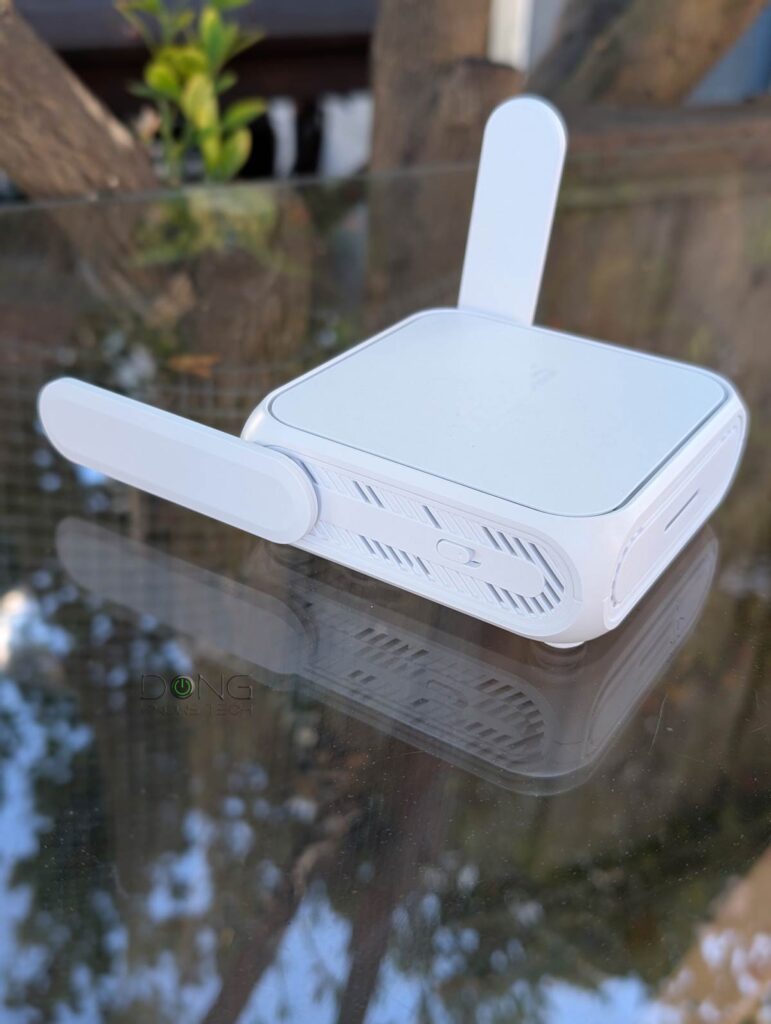
ASUS RT-BE58 Go’s performance: Reliable Gig+ real-world Wi-Fi meets slow NAS rates
I tested the RT-BE58 Go for over a week and was generally happy with it, considering its size and purposes.
First of all, you can totally use it as a standard router for a small home with Gig+ or slower Internet. Despite its tiny shape, it has everything to deliver in both security and features for a typical home network. In my trial, its Wi-Fi range proved similar to that of the RT-BE57 Go.
Wi-Fi coverage is always tricky to figure out, but if you have a place of around 1500 ft2 (139 m2), place this little router in the center, and chances are it’ll reach every corner. And that’s quite impressive for a travel router. When was the last time you had a hotel room larger than a thousand square feet?


In terms of real-world performance, the lack of a 2.5Gbps LAN port means I had to test it via the WAN port, which is the fastest port it has, and it did well. Generally, this port can draw close to 2Gbps out of my 10Gbps Fiber-optic broadband (which typically delivers around 8500Mbps when used with a 10Gbps router)
In terms of Wi-Fi speed, the RT-BE58 Go generally averages between 300 Mbps and Gig+, depending on the distance. And that’s also the Internet speed you can expect from it if you have Gig+ or faster broadband.
Tip
Gig+, or Gig Plus, denotes a speed grade between 1Gbps and 2Gbps. So, it’s 1.5Gbps, give or take a couple of hundred megabits per second, and it’s not speedy enough to qualify as Multi-Gig Ethernet or multi-Gigabit. Intel coined the term to describe its Wi-Fi 6E client chips, the AX210 and AX211, in terms of their real-world speeds.
Gig+ primarily applies to sustained Wi-Fi 6 or Wi-Fi 7 speeds via a 2×2 at 160MHz connection, or to broadband internet speeds.


I tried out the router’s USB tethering, and it worked as intended. You can use that alongside the WAN port in a dual-WAN setup. In this case, the cellular connection can serve as a backup. The router’s USB port delivers enough juice to keep my Pixel 9 Pro charged during the testing.
What this USB port didn’t do well at all, however, is the support for network-attached storage (NAS) when hosting a portable SSD. In this case, it maintains a sustained speed of around a few tens of megabytes per second, slower than most Gigabit routers with the same feature. However, NAS is not really what you’d expect from a travel router.

Other than that, the ASUS RT-BE58 Go proved to be reliable, passing my 3-day stress test without any issues. Without an internal fan, it was utterly silent, but it did become a little warm during operation, never hot enough to cause concern.
ASUS RT-BE58 Go's Rating
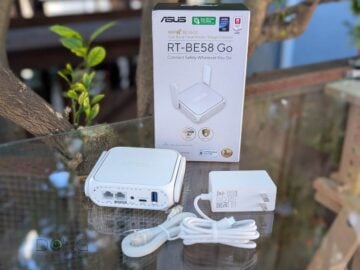
Pros
Wi-Fi 7 support with a 2.5Gbps WAN port and versatile WAN options, Gig+ real-world rates, reliable performance
Identical features and network settings as full-size routers managed via a full web user interface, mesh-ready
Compact design, wall-mount-ready, standard USB-C charging
Cons
No built-in cellular modem, SIM slot, or battery option
A tad expensive, no second 2.5Gbps port
Slow NAS performance when hosting a portable drive
Conclusion
From the look of it, the RT-BE58 Go is very much an enhanced version of the RT-AX57 Go. In many ways, Wi-Fi 7 support is nice to have, but in terms of real-world performance, unless you have faster-than-Gigabit Internet at the location, there’s likely no difference between the two ASUS travel routers.
Compared to the TP-Link TL-WR3602BE, the ASUS RT-BE58 Go has more features—such as the support for Instant Guard and AiMesh, which alone are enough to make up for its slightly higher suggested retail cost—but if getting connected to the Internet is the only thing you care about, there’s also little difference between these two rivals.
That said, looking for a little router to bring on the go for the upcoming holiday season? Consider one of these routers today.

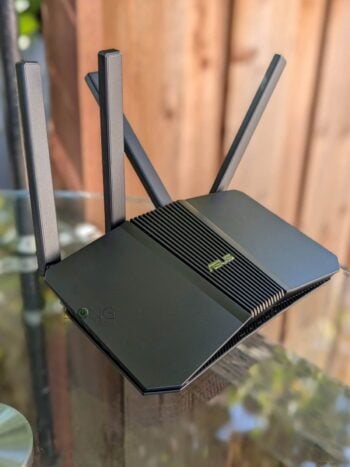

May I know if this asus router could act as an aimesh main router? I mean if i could get two to form a mesh router?
Yes, Bong. And that was mentioned in the review. 🙂
Cool. I will post this here, and the Archer BE230 ones in that review. Thanks for letting me share these.
https://imgur.com/a/HlgLOlM
I was able to see the circuit board for one of these recently. One thing I found odd is the decision to use Front End modules for the 5Ghz radio only. The 2.4 Ghz radio has a discrete switch and LNA instead of a FEM. I thought that was an unusual place to cut costs even for a travel router that doesn’t need the same range as a standard router. The board is otherwise well made, with a BCM6764, a BCM50901, and adequate EMI shielding throughout, as well as a beefy heatsink for the CPU and memory.
5GHz is the most popular band. So, that, if true, kinda makes sense.
Yeah I would agree with that. It’s just like, that saved Asus maybe a dollar or two per unit which likely adds up but it just seems unusual since it would probably have been easier design wise to just use 4 FEMs, lol. Anyway, I can share the photos if folks are interested, not sure what the rules are about that in this space. I also have internal photos of the Archer BE 230 as well. These are my own photos, it is my understanding that occasionally the FCC also posts internal photos of these devices as part of their certification process. I just find it interesting as a hardware nerd to see how these devices are implemented.
You can share links to your photos, Anthony.